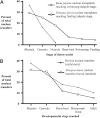The first half-century of nuclear transplantation
- PMID: 12821779
- PMCID: PMC166179
- DOI: 10.1073/pnas.1337135100
The first half-century of nuclear transplantation
Abstract
Fifty years after Briggs and King first succeeded in obtaining normal tadpoles from transplanted embryo nuclei in vertebrates, two general principles have emerged from work in amphibia and mammals. One is the conservation of the genome during cell differentiation. A small percentage of adult or differentiated cells have totipotent nuclei, and a much higher percentage of cells committed to one pathway of cell differentiation have multipotent nuclei. The other is the remarkable reprogramming capacity of cell, and especially egg, cytoplasm. The eventual identification of reprogramming molecules and mechanisms could facilitate a route toward cell replacement therapy in humans.
Figures



Similar articles
-
The first half-century of nuclear transplantation.Biosci Rep. 2004 Aug-Oct;24(4-5):545-57. doi: 10.1007/s10540-005-2744-5. Biosci Rep. 2004. PMID: 16134025 No abstract available.
-
Nuclear transplantation, the conservation of the genome, and prospects for cell replacement.FEBS J. 2017 Jan;284(2):211-217. doi: 10.1111/febs.13988. FEBS J. 2017. PMID: 27973726 Review.
-
Origin and progress of nuclear transfer in nonmammalian animals.Methods Mol Biol. 2006;348:3-32. doi: 10.1007/978-1-59745-154-3_1. Methods Mol Biol. 2006. PMID: 16988369 Review.
-
Nuclear transfer to eggs and oocytes.Cold Spring Harb Perspect Biol. 2011 Jun 1;3(6):a002659. doi: 10.1101/cshperspect.a002659. Cold Spring Harb Perspect Biol. 2011. PMID: 21555407 Free PMC article. Review.
-
The golden anniversary of cloning: a celebratory essay.Differentiation. 2003 Sep;71(7):398-401. doi: 10.1046/j.1432-0436.2003.7107002.x. Differentiation. 2003. PMID: 12969332
Cited by
-
Forcing cells to change lineages.Nature. 2009 Dec 3;462(7273):587-94. doi: 10.1038/nature08533. Nature. 2009. PMID: 19956253 Review.
-
Cell-free embryonic stem cell extract-mediated derivation of multipotent stem cells from NIH3T3 fibroblasts for functional and anatomical ischemic tissue repair.Circ Res. 2008 Jun 6;102(11):e107-17. doi: 10.1161/CIRCRESAHA.108.176115. Epub 2008 May 15. Circ Res. 2008. PMID: 18483406 Free PMC article.
-
A gene expression signature shared by human mature oocytes and embryonic stem cells.BMC Genomics. 2009 Jan 8;10:10. doi: 10.1186/1471-2164-10-10. BMC Genomics. 2009. PMID: 19128516 Free PMC article.
-
Cellular plasticity: 1712 to the present day.Curr Opin Cell Biol. 2016 Dec;43:46-54. doi: 10.1016/j.ceb.2016.07.005. Epub 2016 Jul 30. Curr Opin Cell Biol. 2016. PMID: 27485353 Free PMC article. Review.
-
CMD kinetics and regenerative medicine.Am J Transl Res. 2016 Mar 15;8(3):1615-24. eCollection 2016. Am J Transl Res. 2016. PMID: 27186287 Free PMC article.
References
-
- Weismann, A. (1893) The Germ-Plasm: A Theory of Heredity (Walter Scott Ltd., London).
-
- Spemann, H. (1938) Embryonic Development and Induction (Yale Univ. Press, New Haven, CT).
-
- Comandon, J. & de Fonbrune, P. (1939) C. R. Seanc. Soc. Biol. 130 740-748.
-
- Hammerling, J. (1934) Arch EntwMech. Org. 132 424-462. - PubMed
Publication types
MeSH terms
Grants and funding
LinkOut - more resources
Full Text Sources
Other Literature Sources
Medical

